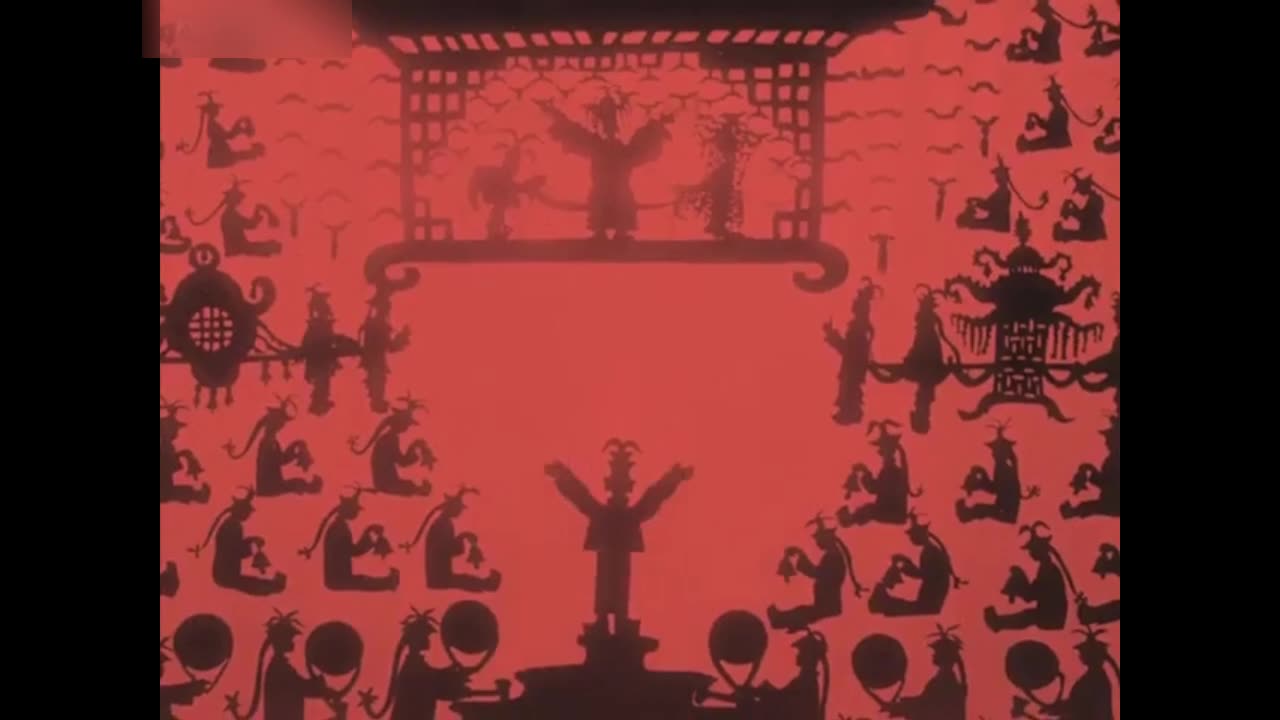Premium Only Content

The Adventures of Prince Achmed (1926)
The Adventures of Prince Achmed (known as Die Abenteuer des Prinzen Achmed in German) is a 1926 German animated fairytale film by Lotte Reiniger. It is the oldest surviving animated feature film; two earlier ones were made in Argentina by Quirino Cristiani, but they are considered lost.[2] The Adventures of Prince Achmed features a silhouette animation technique Reiniger had invented which involved manipulated cutouts made from cardboard and thin sheets of lead under a camera.[3] The technique she used for the camera is similar to Wayang shadow puppets, though hers were animated frame by frame, not manipulated in live action. The original prints featured color tinting.
Several famous avant-garde animators worked on this film with Lotte Reiniger, among them Walter Ruttmann, Berthold Bartosch, and Carl Koch.[4][5]
The story is based on elements from the One Thousand and One Nights written by Hanna Diyab, including "Aladdin" and "The Story of Prince Ahmed and the Fairy Perī-Bānū".
Plot
An African sorcerer conjures up a flying horse, which he shows to the Caliph. When the sorcerer refuses to sell it for any amount of gold, the Caliph offers any treasure he has. The sorcerer chooses Dinarsade, the Caliph's daughter, to her great distress. Prince Achmed, Dinarsade's brother, objects, but the sorcerer persuades him to try out the horse. It carries the prince away, higher and higher into the sky, as he does not know how to control it. The Caliph has the sorcerer imprisoned.
Pari Banu (center) with her attendants, preparing to bathe.
When Achmed discovers how to make the horse descend, he finds himself in a strange foreign land, a magical island called Wak Wak. He is greeted by a bevy of attractive maidens. When they begin fighting for his attention, he flies away to a lake. There, he watches as Pari Banu, the beautiful ruler of the land of Wak Wak, arrives with her attendants to bathe. When they spot him, they all fly away, except for Pari Banu, for Achmed has her magical flying feather costume. She flees on foot, but he captures her. He gains her trust when he returns her feathers. They fall in love. She warns him, however, that the demons of Wak Wak will try to kill him.
The sorcerer frees himself from his chains. Transforming himself into a bat, he seeks out Achmed. The prince chases the sorcerer (who has turned into a kangaroo) and falls into a pit. While Achmed fights a giant snake, the sorcerer takes Pari Banu to China and sells her to the Emperor. The sorcerer returns and pins Achmed under a boulder on top of a mountain. However, the Witch of the Flaming Mountain notices him and rescues Achmed. The sorcerer is her arch-enemy, so she helps Achmed rescue Pari Banu from the Emperor. Then, the demons of Wak Wak find the couple and, despite Achmed's fierce resistance, carry Pari Banu off. Achmed forces a captive demon to fly him to Wak Wak. However, the gates of Wak Wak are locked.
He then slays a monster who is attacking a boy named Aladdin. Aladdin tells of how he, a poor tailor, was recruited by the sorcerer to retrieve a magic lamp from a cave. When Aladdin returned to the cave entrance, the sorcerer demanded the lamp before letting him out. Aladdin refused, so the sorcerer sealed him in. Aladdin accidentally released one of the genies of the lamp and ordered it to take him home. He then courted and married Dinarsade. One night, Dinarsade, Aladdin's magnificent palace, and the lamp disappeared. Blamed by the Caliph, Aladdin fled to avoid being executed. A storm at sea cast him ashore at Wak Wak. When he tried to pluck fruit from a "tree", it turned into a monster and grabbed him, but Achmed killed it.
Achmed realizes the sorcerer had been responsible for Aladdin's fate, and is further enraged. He also reveals to Aladdin that his palace and the lamp were stolen by the sorcerer because of his obsession for Dinarsade. Then, the witch arrives. Since only the lamp can open the gates, she agrees to attack the sorcerer to get it. They engage in a magical duel, each transforming into various creatures. After a while, they resume their human forms and fling fireballs at each other. Finally, the witch slays the sorcerer.
With the lamp, they are able to enter Wak Wak, just in time to save Pari Banu from being thrown to her death. A fierce battle erupts. A demon steals the lamp, but the witch gets it back. She summons creatures from the lamp who defeat the demons. One hydra-like creature seizes Pari Banu. When Achmed cuts off one of its heads, two more grow back immediately, but the witch stops this regeneration, allowing Achmed to kill it and rescue Pari Banu. A flying palace then settles to the ground. Inside, Achmed, Pari Banu, Aladdin, and the Caliph find Dinarsade. The two couples bid goodbye to the witch and fly home to the palace.
Production
[icon]
This section needs expansion. You can help by adding to it. (August 2015)
Reiniger required several years, from 1923 to 1926, to make this film.[5] Each frame had to be painstakingly filmed, and 24 frames were needed per second.[5] The reason why an adaptation of Arabian Nights was chosen was based on the idea that the action should show events that would only be possible with animation. In addition to herself, her small team consisted of her husband Carl Koch, Walter Ruttmann, Berthold Bartosch, Alexander Kardan and Walter Turck. A Berlin banker named Louis Hagen financed the movie, and offered the team to use the attic of the garage in his vegetable garden as their studio. Oskar Fischinger made a wax-slicing machine for them which was used to visualize magic in several scenes. Another tool was an early version of the multiplane camera. Stars were made by holding a cardboard with small holes in front of a strong light, superimposed pieces of semitransparent tissue paper was used to make waves, and silver paper for moonlit water. For other movable backgrounds, which sometimes included the use of two negatives, they made different layers covered with substances like sand, paint and soap. For the latter, Bartosch would later say about the production of Prince Achmed: “During my years of work I have learned many things. Soap, it is quite extraordinary, with soap one can do everything.”[6][7]
Censorship
Reiniger was one of the first filmmakers in the 20th century to attempt a portrayal of the queer experience with a pair of openly gay lovers in this film: the Emperor of China and a male character named Ping Pong. Although this was censored in the version of the film that was distributed to theaters, Ping Pong is presented as the Emperor's favourite or darling (Des Kaisers Liebling) even in the censored version. Reiniger herself was outspoken on her motivation to destigmatize homosexual realities in the world of film. "I knew lots of homosexual men and women from the film and theater world in Berlin, and saw how they suffered from stigmatization. [...] I suspect that when the Emperor kisses Ping Pong, that must have been the first happy kiss between two men in the cinema and I wanted it to happen quite calmly in the middle of Prince A[c]hmed so children — some who would be homosexual and some who would not — could see it as a natural occurrence, and not be shocked [n]or ashamed."[8]
Restoration
While the original film featured color tinting, prints available just before the restoration had all been in black and white. Working from surviving nitrate prints, German and British archivists restored[9] the film during 1998 and 1999, including reinstating the original tinted image by using the Desmet method.
Availability
The film is screened on the Turner Classic Movies channel. It was also once available to stream through the subscription-based FilmStruck. Filmstruck's follow-up service, Criterion Channel, a service from the Criterion Collection, began streaming it in Region 1 after the service shuttered in November 2018. English-market DVDs are available, distributed by Milestone Films and available in NTSC R1 (from Image) and PAL R2 (from the BFI).[10] Both versions of the DVD are identical. They feature both an English-subtitled version (the intertitles are in German) and an English voice-over.
The English-subtitled film is available via Fandor and LiveTree.
Legacy
An homage to this film can be spotted in Disney's Aladdin (1992); a character named Prince Achmed has a minor role in the film. The art style also served as inspiration for the Steven Universe episode "The Answer".[11]
Score
The original score was composed by German composer Wolfgang Zeller in direct collaboration with the animation of the film. Reiniger created photograms for the orchestras, which were common in better theatres of the time, to follow along the action.[12]
Contemporary scorings
The Silk Road Ensemble accompanied the film with a live improvised performance on Western strings and instruments such as the oud, ney and sheng in October 2006 at the Rubin Museum of Art in New York, NY.[13] The Silk Road Ensemble repeated the performance at the Avon Cinema in Providence, Rhode Island, in February 2007.[14]
London based band Little Sparta composed an original score to the film in 2007 with notable performances at Latitude Festival (2007), The Edinburgh Art Festival (2009) and Mekonville (2017). They have also had runs at theatres and venues in the UK and are continuing to perform it while releasing an EP of selected cues in June 2008.
New York City band Morricone Youth composed a new score for the film in 2012 and first performed it live at Nitehawk Cinema in Brooklyn on 28 September 2012.[15] Country Club Records released a vinyl 6-song EP of the score in 2016.[16]
Spanish band Caspervek Trio composed a new soundtrack for the movie in 2014 premiered in Vigo, with further performances in Ourense, Liptovský Míkulás and Madrid.[17]
The Scottish jazz quartet, S!nk, composed and performed a new score for the film in 2017 as part of the Hidden Door arts festival in Edinburgh as part of a series of events celebrating the re-opening of the Leith Theatre after being closed for 25 years.[18][19]
Students from the Royal Birmingham Conservatoire composed a score for the film, which premiered at the Flatpack Film Festival at Dig Brew Co. on 22 April 2018 [20]
Chris Davies composed a new score for the opening night of the 2014 Bradford animation festival. Using a mixture of recorded and live instrumentation, he has continued touring extensively, playing live with the film throughout the UK and Europe.
Ben Bentele, David Alderdice, Daniel Be, and Cait Pope composed and improvised a score for the film, which premiered at the Paradise Theater in Paonia, Colorado, USA on 22 April 2023. The performance included a wide array of world instruments and electronic elements.
-
 37:52
37:52
Kimberly Guilfoyle
2 hours agoThe Trump Effect, Plus More Scandals for Leticia James, Live with Roger Stone | Ep213
20.5K10 -
 1:13:45
1:13:45
Kim Iversen
2 hours agoWe're LOSING The Tariff War With China, How Our Elites Sold Us Out | Oct 7th Rape COVERUP
45.5K45 -
 1:23:13
1:23:13
Redacted News
3 hours agoTrump declaring MARTIAL LAW on April 20th according to fearmonger liberals, they want civil war
111K101 -
 2:21:58
2:21:58
vivafrei
10 hours agoEp. 259: Shapiro Home FIREBOMBED! Pavlovski Goes NUCLEAR on Dorsey Over AI! Elections Canada & MORE
96.1K48 -
 LIVE
LIVE
The Amber May Show
3 hours agoFinally, The Truth Comes Out In The News About What We Have Known For A While| Sam Anthony
183 watching -
 LIVE
LIVE
TwinGatz
4 hours ago🔴LIVE - Fighting Side By Side | ARMA Reforger
361 watching -
 1:58:54
1:58:54
Revenge of the Cis
4 hours agoEpisode 1474: Space Cadets
47.6K2 -
 1:11:57
1:11:57
The HotSeat
3 hours agoResurrection Week Kicks Off—And So Does the Democrat Freak Show: AOC and Bernie 2028
37.6K4 -
 LIVE
LIVE
LFA TV
21 hours agoLFA TV - ALL DAY LIVE STREAM 4/14/25
471 watching -
 1:14:08
1:14:08
Jeff Ahern
3 hours ago $1.26 earnedMonday Madness with Jeff Ahern (1pm Pacific)
30.5K4